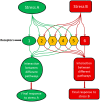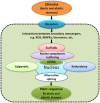Global Plant Stress Signaling: Reactive Oxygen Species at the Cross-Road
- PMID: 26941757
- PMCID: PMC4763064
- DOI: 10.3389/fpls.2016.00187
Global Plant Stress Signaling: Reactive Oxygen Species at the Cross-Road
Abstract
Current technologies have changed biology into a data-intensive field and significantly increased our understanding of signal transduction pathways in plants. However, global defense signaling networks in plants have not been established yet. Considering the apparent intricate nature of signaling mechanisms in plants (due to their sessile nature), studying the points at which different signaling pathways converge, rather than the branches, represents a good start to unravel global plant signaling networks. In this regard, growing evidence shows that the generation of reactive oxygen species (ROS) is one of the most common plant responses to different stresses, representing a point at which various signaling pathways come together. In this review, the complex nature of plant stress signaling networks will be discussed. An emphasis on different signaling players with a specific attention to ROS as the primary source of the signaling battery in plants will be presented. The interactions between ROS and other signaling components, e.g., calcium, redox homeostasis, membranes, G-proteins, MAPKs, plant hormones, and transcription factors will be assessed. A better understanding of the vital roles ROS are playing in plant signaling would help innovate new strategies to improve plant productivity under the circumstances of the increasing severity of environmental conditions and the high demand of food and energy worldwide.
Keywords: abiotic stress; biotic stress; oxidative stress; plant defense; plant stress signaling; reactive oxygen species.
Figures





Similar articles
-
Reactive oxygen species in plants: an invincible fulcrum for biotic stress mitigation.Appl Microbiol Biotechnol. 2022 Sep;106(18):5945-5955. doi: 10.1007/s00253-022-12138-z. Epub 2022 Sep 5. Appl Microbiol Biotechnol. 2022. PMID: 36063177 Review.
-
Enhancement of Plant Productivity in the Post-Genomics Era.Curr Genomics. 2016 Aug;17(4):295-6. doi: 10.2174/138920291704160607182507. Curr Genomics. 2016. PMID: 27499678 Free PMC article.
-
Plant hormone-mediated regulation of stress responses.BMC Plant Biol. 2016 Apr 14;16:86. doi: 10.1186/s12870-016-0771-y. BMC Plant Biol. 2016. PMID: 27079791 Free PMC article. Review.
-
Regulation of ROS Metabolism in Plants under Environmental Stress: A Review of Recent Experimental Evidence.Int J Mol Sci. 2020 Nov 18;21(22):8695. doi: 10.3390/ijms21228695. Int J Mol Sci. 2020. PMID: 33218014 Free PMC article. Review.
-
Methylglyoxal - a signaling molecule in plant abiotic stress responses.Free Radic Biol Med. 2018 Jul;122:96-109. doi: 10.1016/j.freeradbiomed.2018.03.009. Epub 2018 Mar 12. Free Radic Biol Med. 2018. PMID: 29545071 Review.
Cited by
-
Comprehensive transcriptome resource for response to phytohormone-induced signaling in Capsicum annuum L.BMC Res Notes. 2020 Sep 18;13(1):440. doi: 10.1186/s13104-020-05281-1. BMC Res Notes. 2020. PMID: 32943083 Free PMC article.
-
Identification of the Cytosolic Glucose-6-Phosphate Dehydrogenase Gene from Strawberry Involved in Cold Stress Response.Int J Mol Sci. 2020 Oct 3;21(19):7322. doi: 10.3390/ijms21197322. Int J Mol Sci. 2020. PMID: 33023038 Free PMC article.
-
Aspartic protease inhibitor enhances resistance to potato virus Y and A in transgenic potato plants.BMC Plant Biol. 2022 May 12;22(1):241. doi: 10.1186/s12870-022-03596-8. BMC Plant Biol. 2022. PMID: 35549883 Free PMC article.
-
The class III peroxidase gene family is involved in ascorbic acid induced delay of internal browning in pineapple.Front Plant Sci. 2022 Aug 3;13:953623. doi: 10.3389/fpls.2022.953623. eCollection 2022. Front Plant Sci. 2022. PMID: 35991401 Free PMC article.
-
Exploring aquaporin functions during changes in leaf water potential.Front Plant Sci. 2023 Aug 8;14:1213454. doi: 10.3389/fpls.2023.1213454. eCollection 2023. Front Plant Sci. 2023. PMID: 37615024 Free PMC article. Review.
References
Publication types
LinkOut - more resources
Full Text Sources
Other Literature Sources

